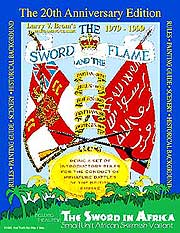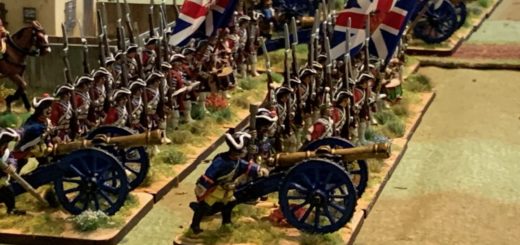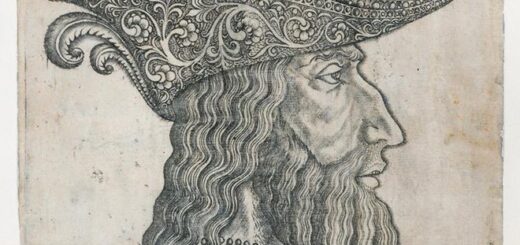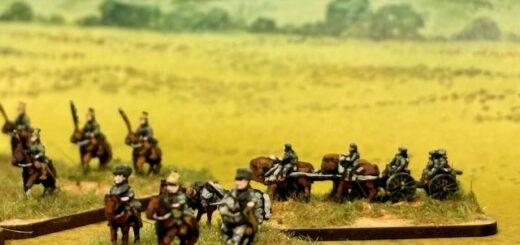The Sword and the Flame

Carte unita’
Sono delle forms pdf che vanno duplicate e riempite con i valori dello scenario.
Regola per la assegnazione dei comandi.
Si assegnano a giocatori volenterosi i comandi in capo.
Gli altri giocatori pescano a caso i fogli delle singole unita’. A seconda di quali unita’ hanno i giocatori saranno nativi o europei. Alcuni giocatori avranno unita’ sia native che europee, essi possono scambiare due nativi per un europeo a con altri giocatori.
I comandanti prima del gioco dovranno:
- riorganizzare le unita’ assegnate ai vari giocatori per riorganizzarle per quanto possibile secondo l’ordine di battaglia.
- dare gli ordini generali, assegnare le truppe sul terreno e imbarcate sulle navi.
- assegnare le munizioni alle truppe.
Segnalini
Formazioni
- VERDE: truppe pancia A TERRA.
Stato
- BIANCO: truppe PINNED.
- GIALLO truppe SHAKEN.
- ROSSO: truppe in ROTTA.
Morale da fare
- BLU: morale CRITICO, truppe shaken che prendono perdite o tutte le unita’ sotto il 50%.
- NERO: morale MAJOR, comando di brigata perso.
“The Sword and The Flame 20th Anniversary Edition” – Errata 1999
Given Larry Brom’s staunch belief in Queen Victoria’s axiom, “Never complain, never explain,” no special preface or designer’s notes will be forthcoming. He has faith in his readers’ abilities to figure the rules out for themselves and in creative ways that have helped the game not only survive these twenty years, but flourish.
However, as seems to be inevitable with any rules (even those as well established as TSATF), textual errors have appeared only after going to press. So as to level the playing field for all, Larry has instituted this Official Errata Page and made these first public corrections
The Firing Table:
Pathan Jezail weapon range is 30″ rather than 36″
The Movement Table:
Cavalry Rough Terrain Penalty is defined on page 24, (g.) Rough Terrain Penalty.
The Movement Table is incorrect regarding this and so is the following sentence on page 22 under (3.) Movement Through Rough Terrain, that reads “…and all mounted forces.” Delete that portion of the sentence.
For British Infantry in Close or Square formation, an asterisk after the number “3” under Charge is missing, as well as a note below the Table stating, “*Close Order Formation Only.”
On Page 29
D.4. Surrounded Figures, the first sentence should read;
“Losing figures in a close-combat (who are now shaken) that are surrounded and must retreat, follow this procedure:”
On page 26
3. Wounded Figures, add the following line to the end of the paragraph.
“Natives do not care for, nor carry, their wounded”.
On Page 9
the diagram for the Imperial Cavalry Troop (12 Figures) should contain only 12 figures, total (10 troopers plus a Lieutenant and a
Sergeant).
The Sword and The Flame – Official Rules Changes 2003
G. Scouts (Page 20) add to existing paragraph
Scouts and unattached leaders automatically attempt to evade any enemy unit charging them to initiate a Close Combat. As the charging unit moves towards them the scouts/leaders roll movement dice (foot figures 3, mounted figures 4), disregarding any terrain penalties. If they roll enough move distance to evade the charging figures they are safe. If not, they are killed on the spot and no Close Combat occurs.
C. Square Formations (Page 20)
add to existing paragraph
There are two options for moving and changing a Square;
1) Roll two movement dice and keep the same configuration and facing direction and move to the new location.
2) Stand in place and totally change the configuration of the Square.
B. March Column Formations (Page 20)
add to existing paragraph
Columns of more than two units on a road have two movement options;
1) Roll movement dice for each unit as their cards are drawn if you wish to deploy and change facing in the new location.
2) Roll movement dice (on one card) for the whole multi-unit column – all units move as one, the same distance. These units will end their movement in road column facing forward on the road.
A. The Card Deck (Page 21) make this change
Add two jokers to the movement deck – mark one Red and one Black.
1. Random Order Of Movement (Page 21)
add to paragraph a.
During the movement phase of a game turn any time a Joker is turned that color player – Red or Black gets a Bonus move and can move any one of his units that has already moved again. Ignore the Jokers during the firing phase of the turn.
Cavalry Rough Terrain Movement (Page 24)
Movement penalty for Phased Move Cavalry is defined on page 24 in the upper right hand column and not on the Movement table in the Rough Terrain Penalty column.
Viewing Concealed Figures (Page 24)
replaces 1. under heading b
Concealed figures can be âseenâ in woods, gullies, ravines, scrub brush, rock-strewn areas, behind solid walls, in structures, etc. when an enemy figure moves within 4â of said concealment area and declares, âvisibilityâ. Visibility distance into the concealment area is six inches (6â).
4. Pass Through Fire (Page 26)
Delete from the first sentence â…..and that unit has not moved yetâ.
Page 26, b. (Top of left hand column)
Replace the existing paragraph with this one;
âThe target area for artillery and machine guns is determined by considering a 60 degree arc of fire from the muzzle of the weapon out the full range of the gun. Any foremost unit/gun within this arc can be designated as a target.â (See Target Designation).
C. Figures That Cannot Fire (Page 27)
g. Horse holders do not fire.
10. Optional Rule – Cavalry (Page 27)
replaces existing text
If mounted cavalry units take hits, consider all the face cards turned up when determining casualties as horse hits and not riders. Dismounted riders can be carried by mounted men as defined on page 23, Carrying Wounded..
IX. The Close Combat Phase (Page 27)
Change the 3rd sentence of the introduction paragraph to read. âThese can occur whenever opposing figures make physical contact as a result of a unit making a âChargeâ move during the Movement Phaseâ.
7. Pistols (Page 27)
replaces existing text
Pistol armed officers/native leaders fire separately from their units. Pistol range is 6â. Officers/native leaders must be in the firing line. For aimed fire 1 shot is allowed. Random firing (drawing casualty cards) offers two shots. No figure may carry both a pistol and a longarm. Officers/native leaders forfeit their pistol shots while serving a machine gun or fieldpiece.
3. If Shaken Figures Are Charged (Page 29)
replaces existing text
…before they can attempt to rally they will roll 1 D6 for casualties and immediately move off the nearest table edge and out of the game The attacker merely has to roll enough move distance for contact – no Morale rolls.
1. Walls And Obstacles (Page 29)
replaces existing text
Combatants may not fight across walls or obstacles. The attacker must move up to the wall or obstacle on one turn and stop. Both opponents can fire if applicable and both are considered Class IV targets. When the attacker attempts to charge over and close with the defender on the next turn, any stragglers stand in place. The others move on top of the obstacle and fight there if a Close Combat occurs.
8. Firing Into Close Combats (Page 30)
add as new topic under 7. CAVALRY
When an announced attacking unit moves in and stops within 1â of a defending unit, said units are considered âclosing into combatâ. During the fire phase of that turn these âmixed-targetâ units can be fired at by any non-engaged units (they are Class I Mass Targets). When casualty cards are turned all Jacks, Queens, Kings and Aces inflict casualties in the unit of the side that fired.
9. Attacking A Square (Page 30)
add as new under 8. Firing Into Close Combat
The charging figures must each move their maximum Charge distance and flow around the Square contacting as many opponents as they can before they start doubling up on the defenders. The defenders can support the fight with any figures inside the Square within 2â. If the defenders lose the fight the whole Square is considered broken and all survivors move to the direct rear a 4 D6 move distance.
4. Surrounded Figures (Page 29)
replaces existing text
Losing figures in a Close-Combat (who are now âShakenâ) that are surrounded and must retreat, follow this procedure:
4. If Figures Of Both Sides (Page 28)
replaces the 1st and 2nd sentences of topic a.
Move each of the charging figures their maximum move distance into single contact with as many individual defenders as possible before doubling up on them.
B. Limited Ammunition (Page 31)
replaces existing 1st paragraph
To simulate the ammunition supply problems in remote areas of conflict, Try this option: Total the number of units (horse, foot and guns) in each opposing force. Roll 2 D6 for each Imperial (and allied) unit. Roll 1 D6 for each Native unit with firearms or guns. Divide the total dice roll for each force by the number of units in the force and the resultant number is the number of firing increments per unit for the upcoming battle. Neither side shall know of the opponents available firing increments.
D. Open Order Formation (Page 20)
âbases at least 1/2â apart rather than 1â
b. Charge Move (Page 21)
No stragglers with a roll of 5 and 6 on the die.
The Movement Table (Inside front cover)
Units in Square formation cannot Charge.
Close Combat General Modifiers (Inside back Cover)
+1 Lance Armed (1st roll only) is for Charging Lancers only.
Additional Unit Factors (Page 11)
Indian troops are as Egyptians.
Colonial Troops are as Boers.
Ghurka Infantry = 84 Factors.
Sudanese Infantry = 77 Factors.
Pathan Spear Units = 48 Factors.
Fuzzie-Wuzzie Spears = 47 Factors



